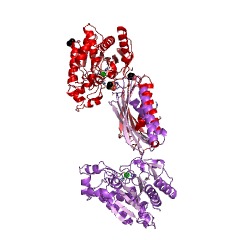| Synonyms |
AtcC, BsLcar, carbamoylated amino acid carbamoylase, hyuC, immobilized L-N-carbamoylase, L-carbamoylase, L-methionine-N-carbamoylase, L-N-carbamoylamino acid aminohydrolase, L-N-carbamoylase, L-NCC amidohydrolase, Lnc, LNCA, N-carbamoyl-amino-acid amidohydrolase, N-carbamoyl-L-alpha-amino acid amidohydrolase, N-carbamoyl-L-amino acid amidohydrolase, N-carbamoyl-L-amino-acid amidohydrolase, N-carbamoyl-L-amino-acid hydrolase, N-carbamoyl-L-cysteine amidohydrolase, N-carbamoyl-L-cysteine-acid amidohydrolase, N-carbamyl-L-amino acid amidohydrolase, NCC amidohydrolase, SmLcar |
| Comments |
This enzyme, along with EC?3.5.1.77?(N-carbamoyl-D-amino-acid hydrolase), EC?5.1.99.5?(hydantoin racemase) and hydantoinase, forms part of the reaction cascade known as the “hydantoinase process”, which allows the total conversion of?D,L-5-monosubstituted hydantoins into optically pure?D- or?L-amino acids [3]. The enzyme from?Alcaligenes xylosoxidans?has broad specificity for carbamoyl-L-amino acids, although it is inactive on the carbamoyl derivatives of glutamate, aspartate, arginine, tyrosine or tryptophan. The enzyme from?Sinorhizobium meliloti?requires a divalent cation for activity and can hydrolyse?N-carbamoyl-L-tryptophan as well as?N-carbamoyl?L-amino acids with aliphatic substituents [2]. The enzyme is inactive on derivatives of?D-amino acids. In addition to?N-carbamoyl?L-amino acids, the enzyme can also hydrolyse formyl and acetyl derivatives to varying degrees [1,2]. |


